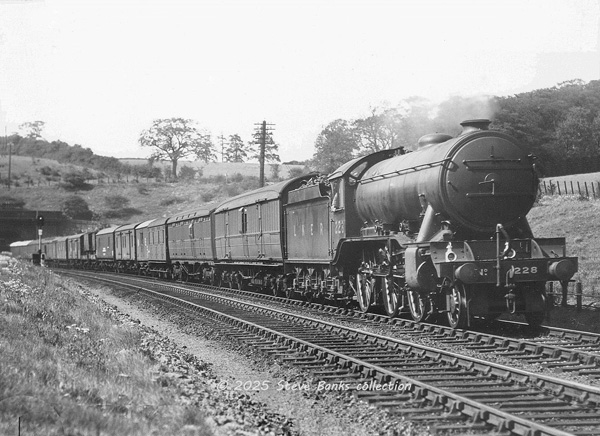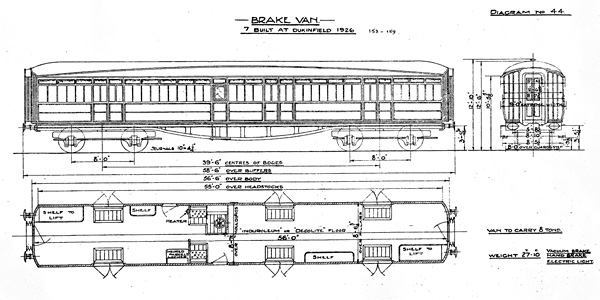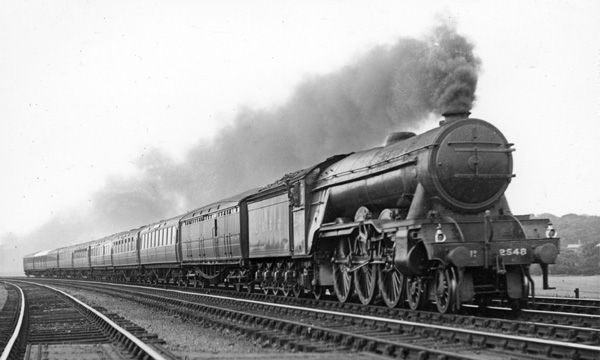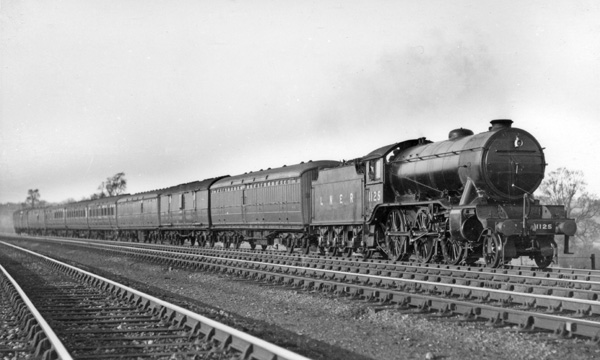From sleeping cars to BGs
There were three lots of LNER conversions from no-longer-wanted sleeping cars to BGs:
D.44 D.207 D.208
and a full account is in the pipeline. Meanwhile here is some fresh info and a bit of puzzle...
New addition placed here temporarily:
At last, a photo of one of the last conversions has turned up!

New England's K3 No 228 is at Ganwick in 1938 with an Up parcels train that is going to take pages if I try to describe all the NPCS in a superbly sharp photograph. I'll start with the leading two bogie vans:
BG |
ex-ECJS |
56'6 |
York ducket |
BG |
ex-ECJS |
58'6"' |
D.207 |
The two Diagrams D.207 and D.208 are very similar but can be distinguished by a different arrangement of ventilator bonnets over the doors. D.208 also shows a continuous solebar footstep although I'm not sure how reliable this detail was. Either way, both differences point to D.207. Note that the Diagram shows 8' Fox bogies with heavy journals whereas this photograph shows the Gresley version. Photo: Photomatic.
Click on the image for an enlargement
Some basic design developments of LNER BGs
This is relevant because design of LNER BGs progressed but the conversions were made between significant changes and can be hard to understand. It's a blind spot for many modellers anyway because of a tendency by RTR and kitmakers to focus on a single design from the mid-'30s.
1924 - saw the LNER's first "standard" 61'6" BG as a modernisation of previous designs that had been 56'6" long and had plug doors (see separated topic). In the new design (D.43) double doors were established and:
- no guard's ducket; - panelling above the waist was narrow; - glazed toplights above the double doors and the penultimate toplight at each end made openable with vertical hinges so that, depending on the direction of travel, air could be forced into the vehicle or, by the Venturi effect, sucked out. This concept was improved upon when the 4w vans to D.120 were designed a few years later, but that's another story. The glazed toplights over the double doors and the opening ones help identify D.43 in photographs of trains and all these features were deployed when the first conversions were made to D.44 in 1926.
1929 - these features were revised five years later after D.45 (the all steel version of 1927, see separate topic) had been built and teak D.113 was introduced, and were to stay constant for all further Gresley BGs:
- duckets were reinstated; - wider panels above the waist; - opening toplights dropped. - ventilator bonnets fitted over the doors;
GE Section - saw a regional variation with bogie vans following the 4w D.120 design with improved ventilation by having both types of ventilation.
When the second and third conversions were made in 1935, their ventilation and glazing was inconsistent and this is hard to explain:
- D.207 was as per current practice, ie. D.45/113 - but D.208 was like previous practice. ie. D43
I mention this because it's visibly the case and to show that when things change, it's not always done systematically.
The first conversions: D.44 (56'6")
Of the three conversions the most numerous was to D.44 with 7 built in 1926 and this is a cautionary tale of how things can get lost over the years. In his last book Michael Harris (1998) described them as "possibly built on the underframes of former GCR-built ambulance train vehicles which were purchased by the LNER from a contractor". This wasn't the only time that dear old Michael when stumped, offered this kind of explanation. Alarm bells should have rung because the GCR never built to this length and the bowstring girder trussing was NER-style.

They had been built by York as ECJS 56'6" sleeping cars and the early LNER made an attempt to update that fleet and present a corporate image soon after the Grouping. The sleeping cars needed modernising anyway and when a large batch was built new for a predominantly 1st class market, many of the older ones were withdrawn and EC.64 on bowstring girder trussing was chosen for conversion to BGs - for the EC fleet. There's quite a long story here that's going to Back Track but suffice to say, the conversions were a quantum leap from earlier, 56'6" BGs (see separate topic). Three old-fashioned features had been abandoned in D.43 and the new length of 61'6":
- the plug doors (in favour of hinged double doors) - skylights on the roof (in favour of toplights under the cornice) - the ugly Howlden ducket (in fact no ducket was provided for the guard at all).
The new body set the trend for all future BGs for the next twenty years and the conversions were in the same mould and also put in the ECJS fleet, numbered 153-9. The later Thompson/BR numbers were 70029-35, eventually with "E" prefix and suffix.
Click on the image for an enlargement

E70032E was captured at High Meads on 18th September 1960. Still in good running order.
The bowstring girder trussing shows well, as do the Fox bogies, heavy wooden headstocks (the solebars were steel) and oval buffers. Note the inward-opening guard's door.
The van makes a pleasing change from the 61'6" design and there is rumour that an etched brass kit may appear in the fullness of time.
Click on the image for an enlargement
D.44 in service
After a spell running with top flight expresses, these BGs settled down in the heavy Anglo-Scottish parcels traffic, operating with long distance overnight trains, such as the sleepers, and the Saturdays-only KX 8.15pm EC Parcels. In all three cases, D.44 vans were marshalled in pairs: setting off together but for different destinations. They came back from their far-flung destinations by an assortment of services, including a meandering one via Edinburgh, St.Boswells and Berwick which would have involved attachment to some low-level trains. Because these BGs were part of the EC fleet it's not surprising that they were photographed on the ECML, where the variety of BGs was greater than is generally recognised.

This undated view was taken during the late 1930s and shows A1 No 2548 Galtee More (GRA) at Brookmans Park with an Up express. It's an ECML formation and quite a prestigious one, despite only a single destination board on the roof. Many of the nine carriages are modern ones on steel-angle trussing, there are two 1st class carriages, and catering has been provided by a 12-wheel restaurant car flanked either side by dining cars. And behind the tender, an EC BG instead of a BTK. The bowstring girder trussing is clearly visible. Photo: G.R. Griggs, Photomatic.
Click on the image for an enlargement

This picture dates from the mid-1930s and the back of the print states K2 No 4635 emerging from "Potters Bar tunnel". Alan Soward (thank you!) pointed out that this could not be and we eventually worked out that the location was the south portal of Welwyn South Tunnel, with sidings on the Up side which were removed by 1937.
The Ordinary Passenger train would have been from Leeds or Doncaster (it was a New England loco at the time) and only one passenger carriage can be seen - an ex-GNR Howlden 6w 3rd brake. Ahead of it are two BGs:
- 56'6" with Howlden ducket and plug doors, either ex-GNR or ECJS - 56'6" D.44 with the sleek sides and bow girder trussing showing well. It was probably in a roster which included an ECJS BG. Photo: author's collection.
Click on the image for an enlargement

This marvellous undated view after WW2, on the troughs at Danby Wiske, shows A4 No 16 Quicksilver with the Up "Flying Scotsman". Thompson stock has been introduced with two 1sts (FK,FK) leading, behind which there is a Gresley restaurant triplet set (RTS), one of the pair built in 1938 for the "Scotsman". Thompson coaches continue behind it.
At the head carrying destination boards and serving as the train's luggage van is a BG conversion to D.44. Photo: Real Photographs.
Click on the image for an enlargement

In another undated view but at Egmanton signal box the same loco has the same train, the only visible change at this end being a Gresley "superfirst" instead of the Thompson version, its steel angle trussing contrasting nicely with the bow girder trussing on the D.44 BG behind the tender. Looks like loco and BG had extended runs with the "Flying Scotsman". Photo: author's collection.
The name - It has been stated elsewhere in a slightly mocking way that the village of Egmanton was nearly three miles away, but the fact is that signal boxes were named after the nearest habitation and here there were two and they were equidistant: Egmanton and Weston. The latter lay alongside the GNR and the name could have been needed for a railway structure there. Egmanton was a safer choice.
Presentation of the name has come up again since Simon James assured me that while it may look like "Ecmanton", it is actually Egmanton. I discovered that the font used by the LNER was unusual and the capital letter "G" used by other companies had a drop-down spur or a bar (which is the modern way, eg. "G"). The LNER, however, used neither and its "G" was quite similar to a "C". Some SR name boards took a similar approach but more stylised and very clear. The LNER was the oddball and it's easy to see why the company later chose Gill Sans, a highly legible font still used today.
However, there's another aspect because upper case is not read as easily as lower case, and in modern times, lower case has taken over where clarity and speed of reading is important. A hard-to-read upper case such as the early LNER used has passed into history.
Layout changes - At first, there was a bridge over the road here and plain double track and for almost a hundred years, a conventional, small signal box on the GNML with only Up and Down signals to control. In the above photograph it looks like a level crossing gate-keeper's box but this is deceptive. As far as I can tell, there were several developments during WW2:
- the bridge was replaced by a level crossing. - a facing connection was added towards Dukeries Junction (Tuxford) and its large exchange yard. - a trailing Up connection was also added, hidden by the train (only its starter can be seen).
These connections ran from Tuxford to Egmanton as a quadrupling and it became a busier box as a result, albeit temporarily, the photograph showing the arrangements at their peak. Many additions of this kind were made during WW2 to increase a line's ability to handle goods trains striving to reach a yard, and were removed later. I believe that the signal box itself was removed in 1976 and, today, only plain double track remains and an unmanned level crossing.
Click on the image for an enlargement
The second and third conversions: D.207 (58'6") and D.208 (56'6")
In 1935 four more conversions were made, again from pre-Grouping sleeping cars but this time to two different lengths. Here are the diagrams. I have them both but it's convenient to show Michael Harris's presentation in his last book (1998):

The similarity to established LNER practice for the bodies is evident and the York-style trussing isn't immediately obvious. The two pairs were for the GN Section and the running numbers ran consecutively 4194-4197, and post-Thompson, 70396-70399.
Click on the image for an enlargement
In service
Unable at first to find a single illustration of these four vans I included this view of a roster in the GNML Carriage Working book for 1939 based on a KX-West Riding OP.:

K3 1125 swings pass Brookmans Park with an Ordinary Passenger train in 1938, quite likely the same working as hauled by K2 4635 earlier (see above), with three bogie carriages and various bogie vans fore and aft. At the head are two 61'6" BGs (D.43 and all-steel D.45) with an ex-GNR 51'1 1/2" BV in between. Two more bogie vans on the rear are too blurred to identify.
Click on the image for an enlargement

New England's K3 No 228 is at Ganwick in 1938 with an Up parcels train that is going to take pages if I try to describe all the NPCS in a superbly sharp photograph. I'll start with the leading two bogie vans:
BG |
ex-ECJS |
56'6 |
York ducket |
BG |
ex-ECJS |
58'6"' |
D.207 |
The two Diagrams D.207 and D.208 are very similar but can be distinguished by a different arrangement of ventilator bonnets over the doors. D.208 also shows a continuous solebar footstep although I'm not sure how reliable this detail was. Either way, both differences point to D.207. Note that the Diagram shows 8' Fox bogies with heavy journals whereas this photograph shows the Gresley version. Photo: Photomatic.
Click on the image for an enlargement
Related topics:
Modelling the clerestory BG: is here.
ECJS and GNR 55'6" BG: is here.


